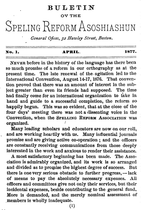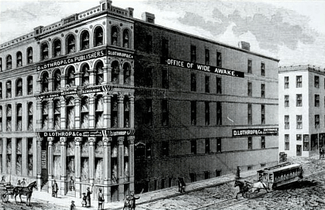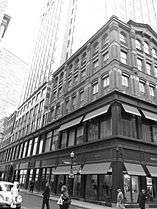Hawley Street (Boston)
Hawley Street of Boston, Massachusetts, is located in the Financial District between Milk and Summer Streets. Prior to 1799, it was called Bishop's Alley and briefly in the 1790s Board Alley.[1]
History
17th century
According to historian Annie Haven Thwing, in 1645 the path that later would become Hawley Street was "laid out through the gardens towards the south windmill, between the houses of Amos Richardson and John Palmer on Summer Street." In the 17th century people referred to it as "'the lane in which the house of Gilbert the tanner stands,' 'a little lane formerly called Gilbert's lane.'"[2]
18th century
After 1728, the lane was "a path through a pasture made by the worshippers of Trinity Church, who lived in King Street."[3] Because the terrain consisted of a marshy bog, wooden planks were laid down to facilitate travel, and so it was referred to as "Board Alley."[4]
In 1792, theatre enthusiasts organized an illegal theatre, the Board Alley Theatre, also called the "New Exhibition Room." With mixed popular opinion, governor John Hancock shut it down in June 1793.[5][6]
19th century
Around the early 19th century, politicians James Sullivan and William Gray lived on the corner of Hawley and Summer Streets.[7] In December 1810, a fire began at Stephen Soper's livery stable, spreading from Hawley to Milk Street, and burning the former home of Benjamin Franklin.[8]
When Melvil Dewey lived in Boston in the 1870s, he served as an officer of the Spelling Reform Association, headquartered at 32 Hawley St.[9]
References
- Boston Street Laying-Out Dept. A record of the streets, alleys, places, etc. in the city of Boston. Boston: City Printing Dept., 1910.
- Thwing. Crooked & narrow streets of the town of Boston 1630-1822. 1920; p.186.
- S. Arthur Bent. Damon and Pythias among our early journalists. New England Magazine, Aug. 1896; p.671.
- Shurtleff. A topographical and historical description of Boston, Part 1, 2nd ed. 1871; p.411.
- American Apollo, Oct. 12, 1792.
- Loren K. Ruff. Joseph Harper and Boston's Board Alley Theatre, 1792-1793. Educational Theatre Journal, Vol. 26, No. 1 (Mar., 1974), pp. 45-52.
- Drake. Old landmarks and historic personages of Boston, 5th ed. 1876; p.388.
- Shurtleff. 1871; p.622.
- Bulletin of the Spelling Reform Association. No.1, April 1877.
Image gallery
 Detail of 1723 map of Boston, showing Bishop's Alley
Detail of 1723 map of Boston, showing Bishop's Alley Announcement for the Board-Alley theatre, American Apollo, Oct. 1792
Announcement for the Board-Alley theatre, American Apollo, Oct. 1792 Hawley Street, Boston, c. 1870
Hawley Street, Boston, c. 1870 Bulletin of the Spelling Reform Association, 32 Hawley St., 1877
Bulletin of the Spelling Reform Association, 32 Hawley St., 1877 D. Lothrop Co., publisher, corner of Hawley and Franklin Streets, c. 1880s
D. Lothrop Co., publisher, corner of Hawley and Franklin Streets, c. 1880s Corner of Hawley and Summer Streets, 2010
Corner of Hawley and Summer Streets, 2010
External links
| Wikimedia Commons has media related to Hawley Street (Boston). |
- Bostonian Society has materials related to the street.
- Library of Congress. Lithograph published by James H. Earle, 20 Hawley Street, 1875.
- MIT. Photo, ca.1954
- Flickr. Photo of Filenes on Hawley, 2008
- Flickr. Corner of Franklin Street and Hawley Street, 2008
- Flickr. Photo, 2009
- Flickr. Photo, 2009